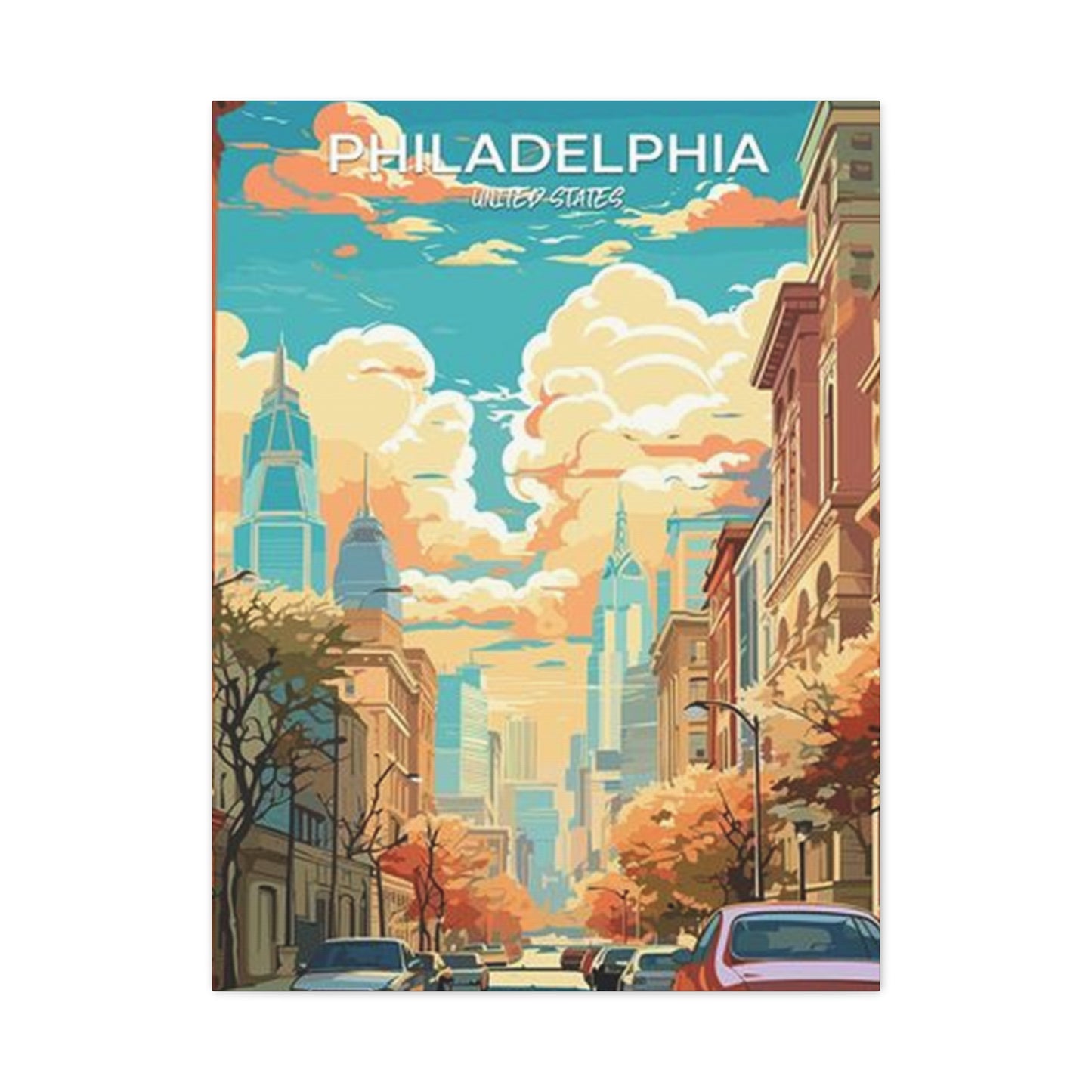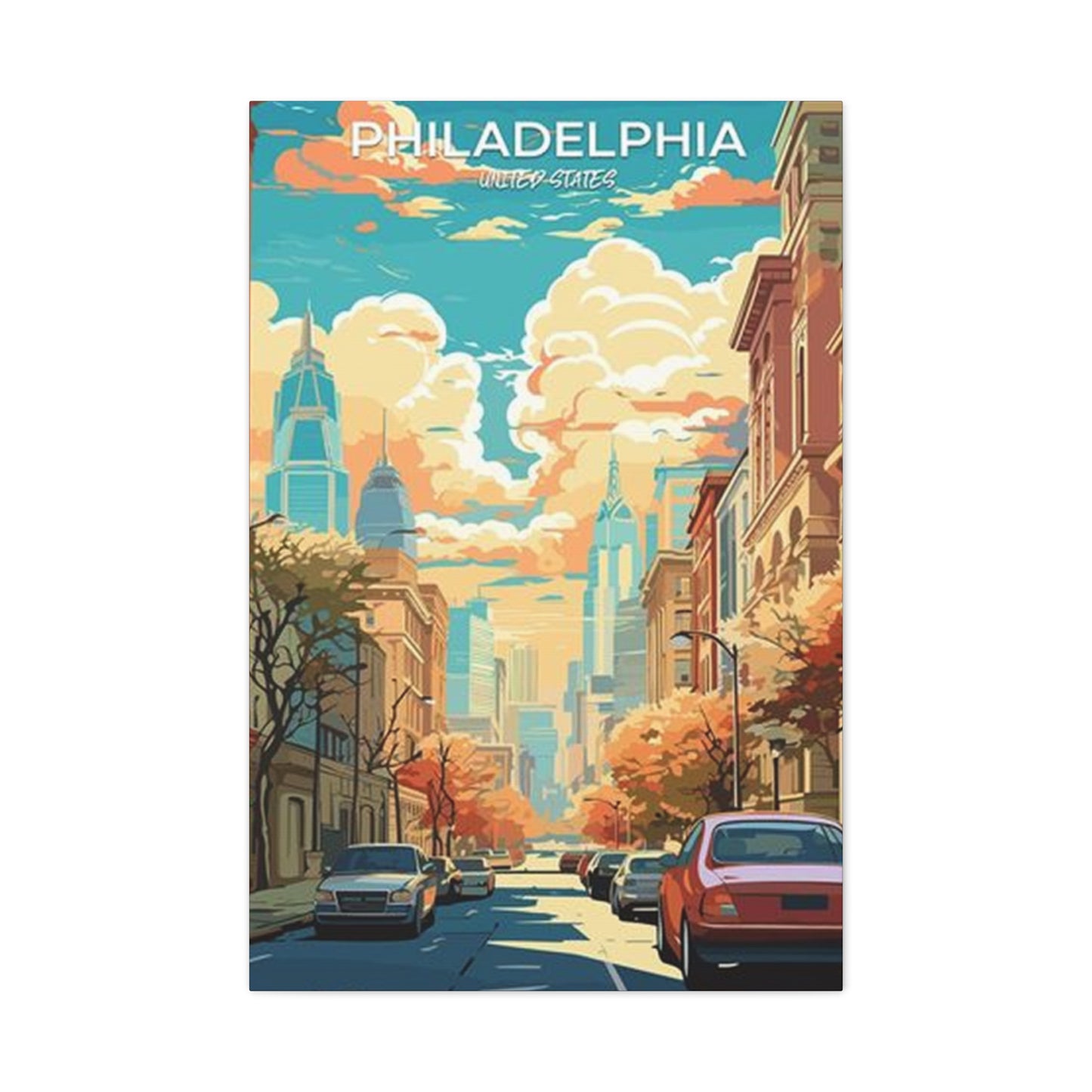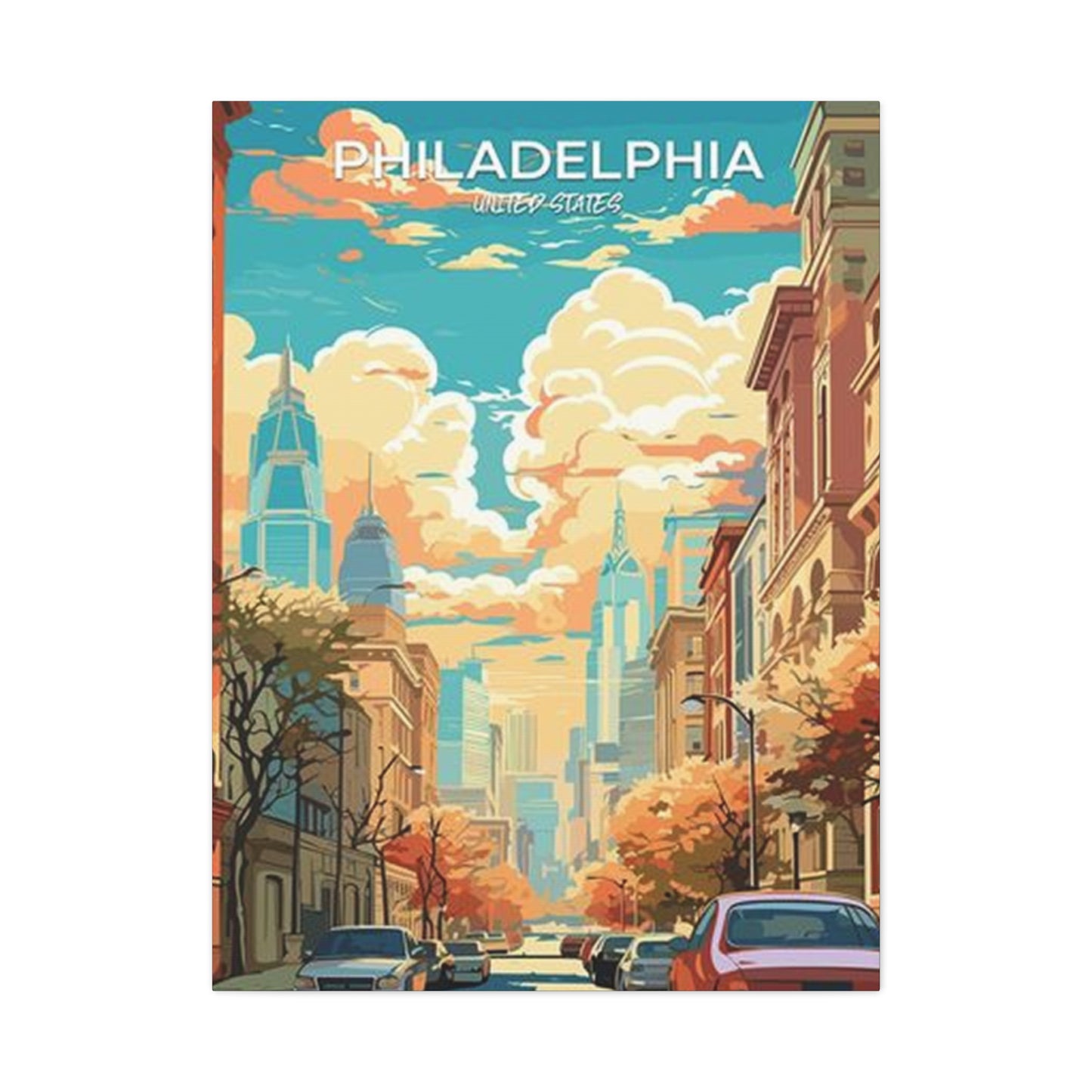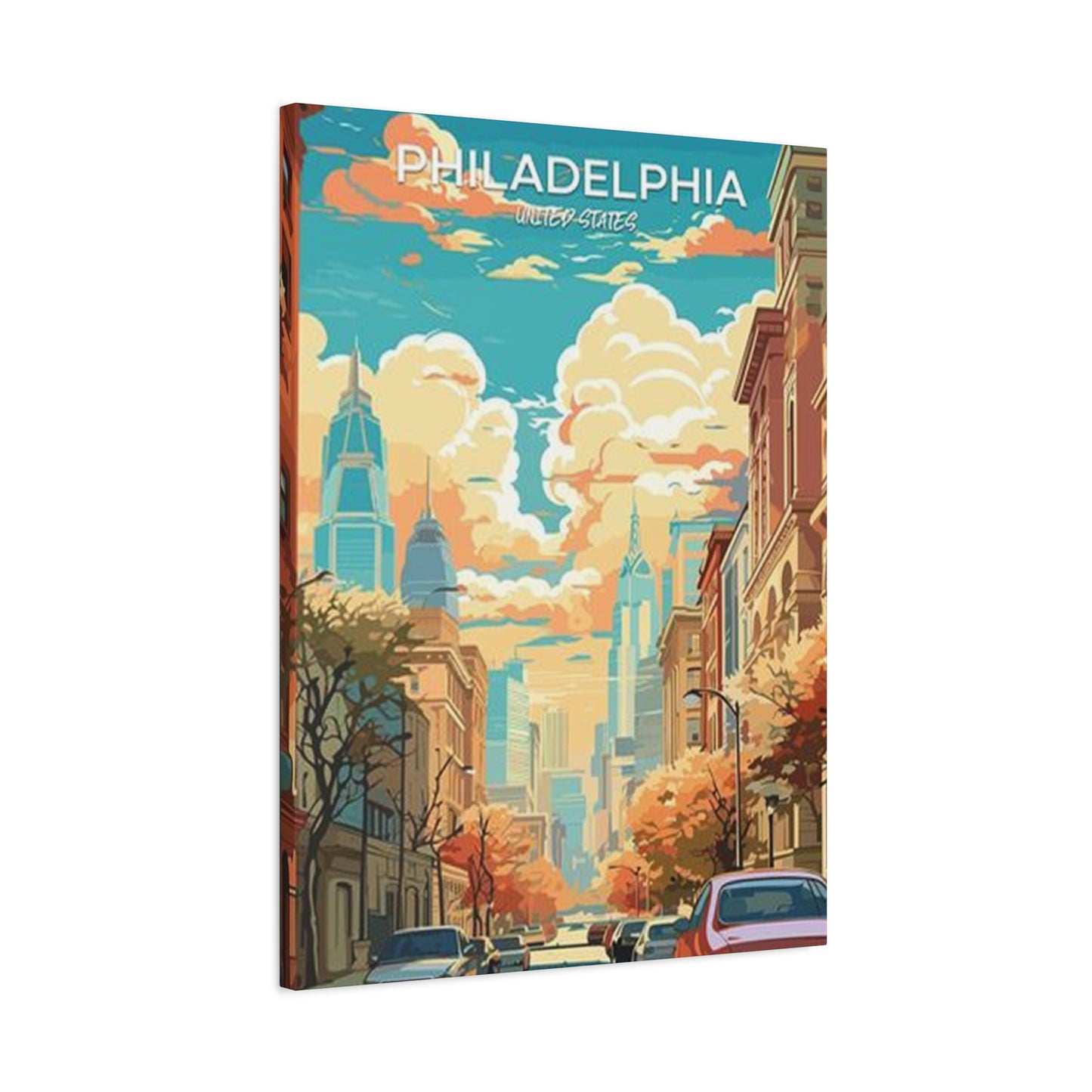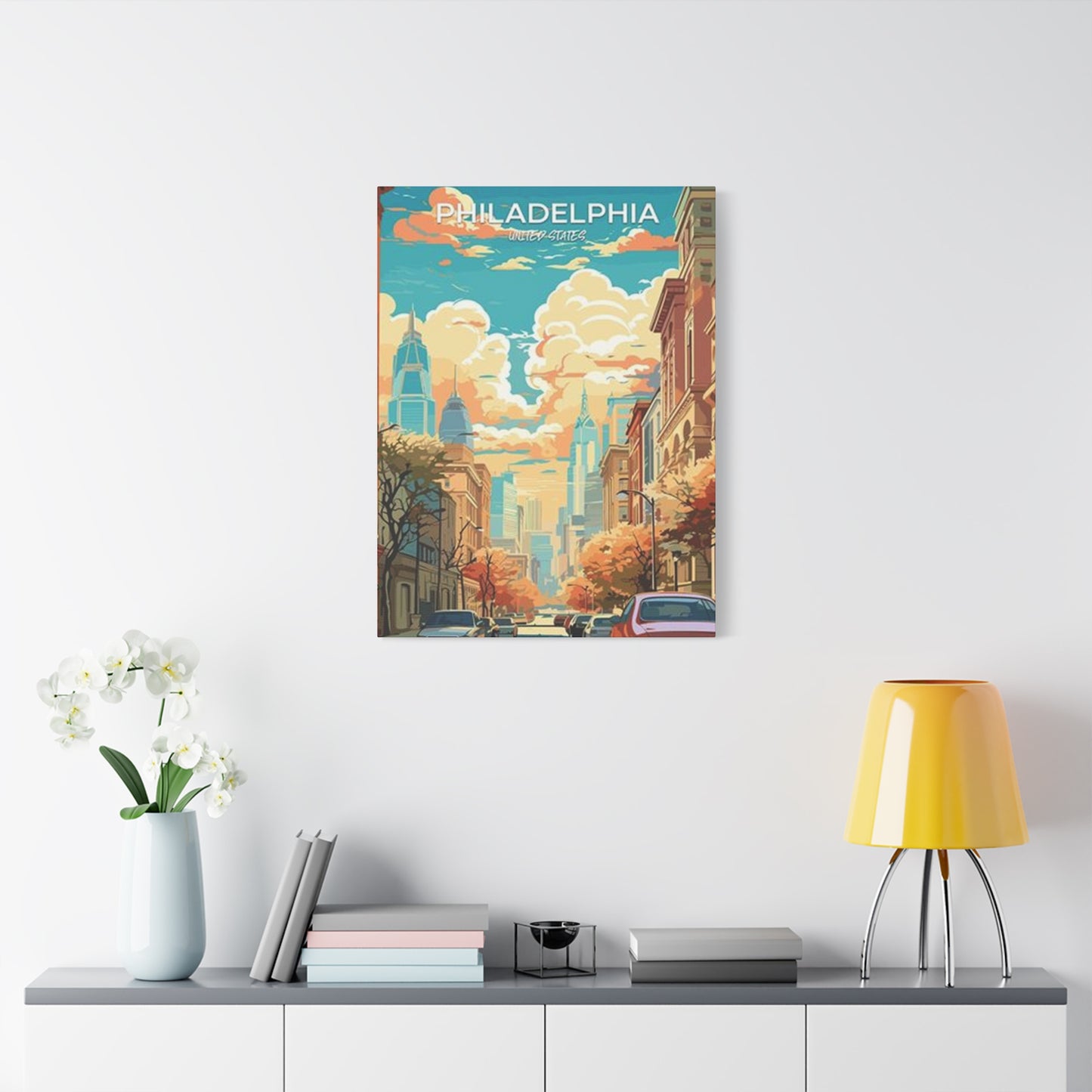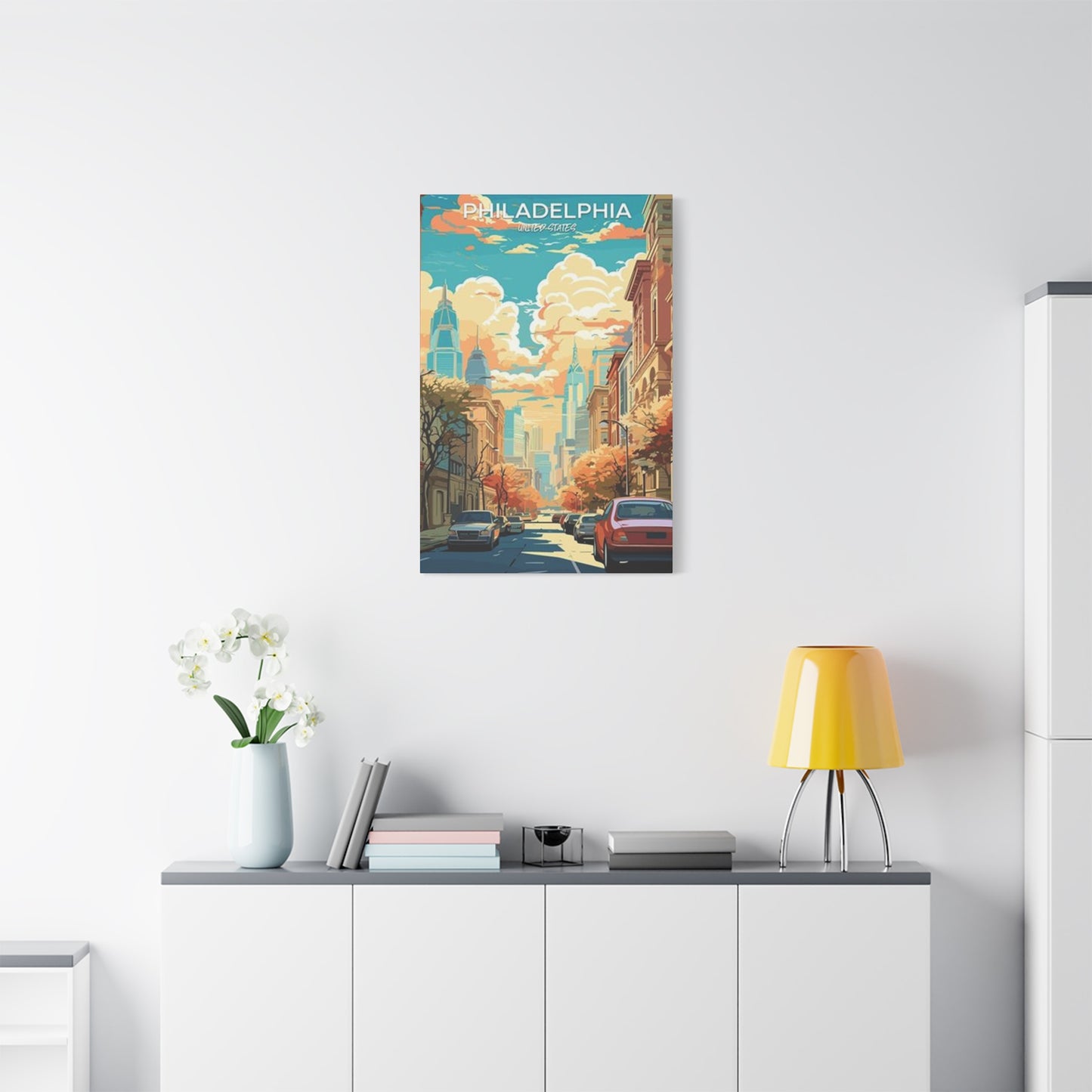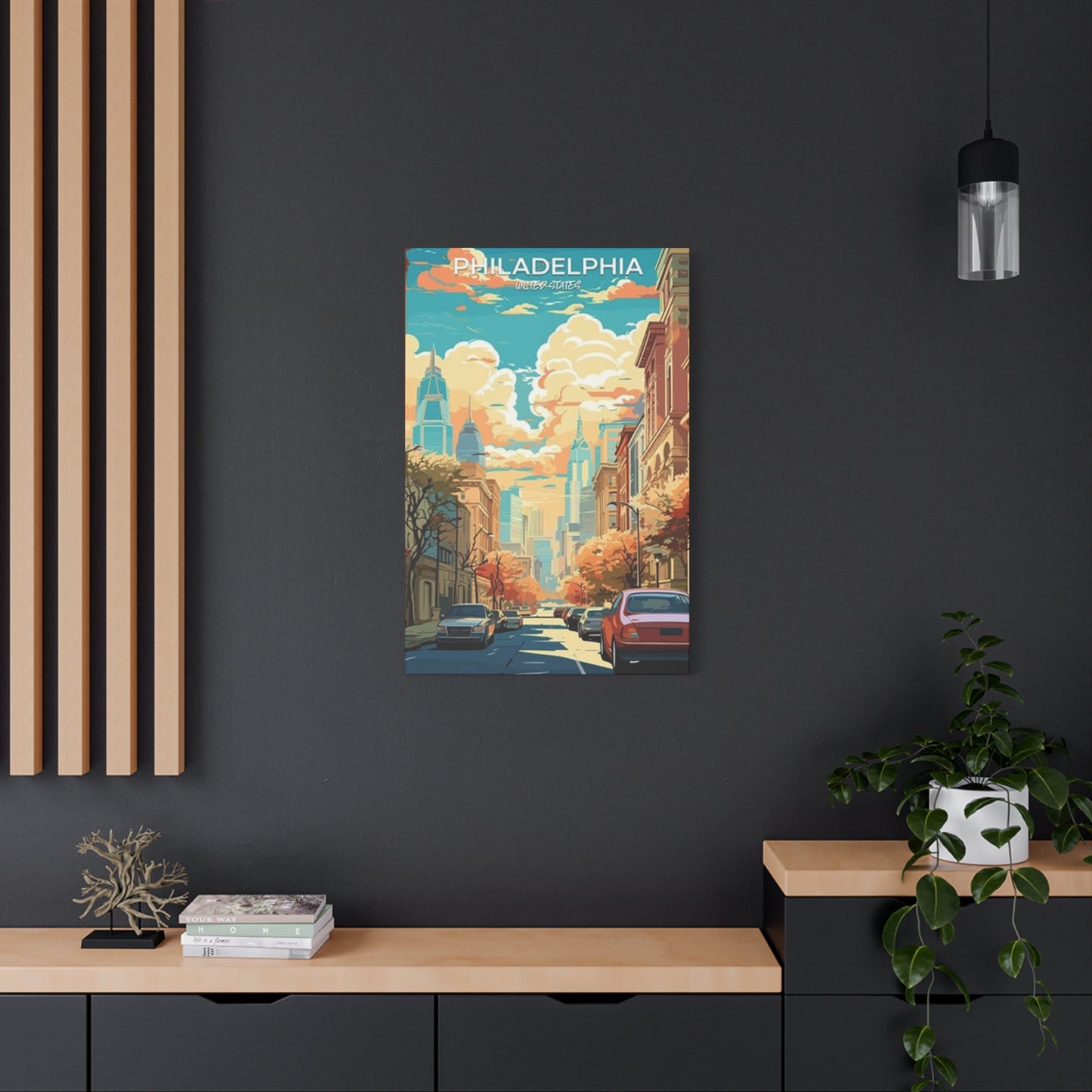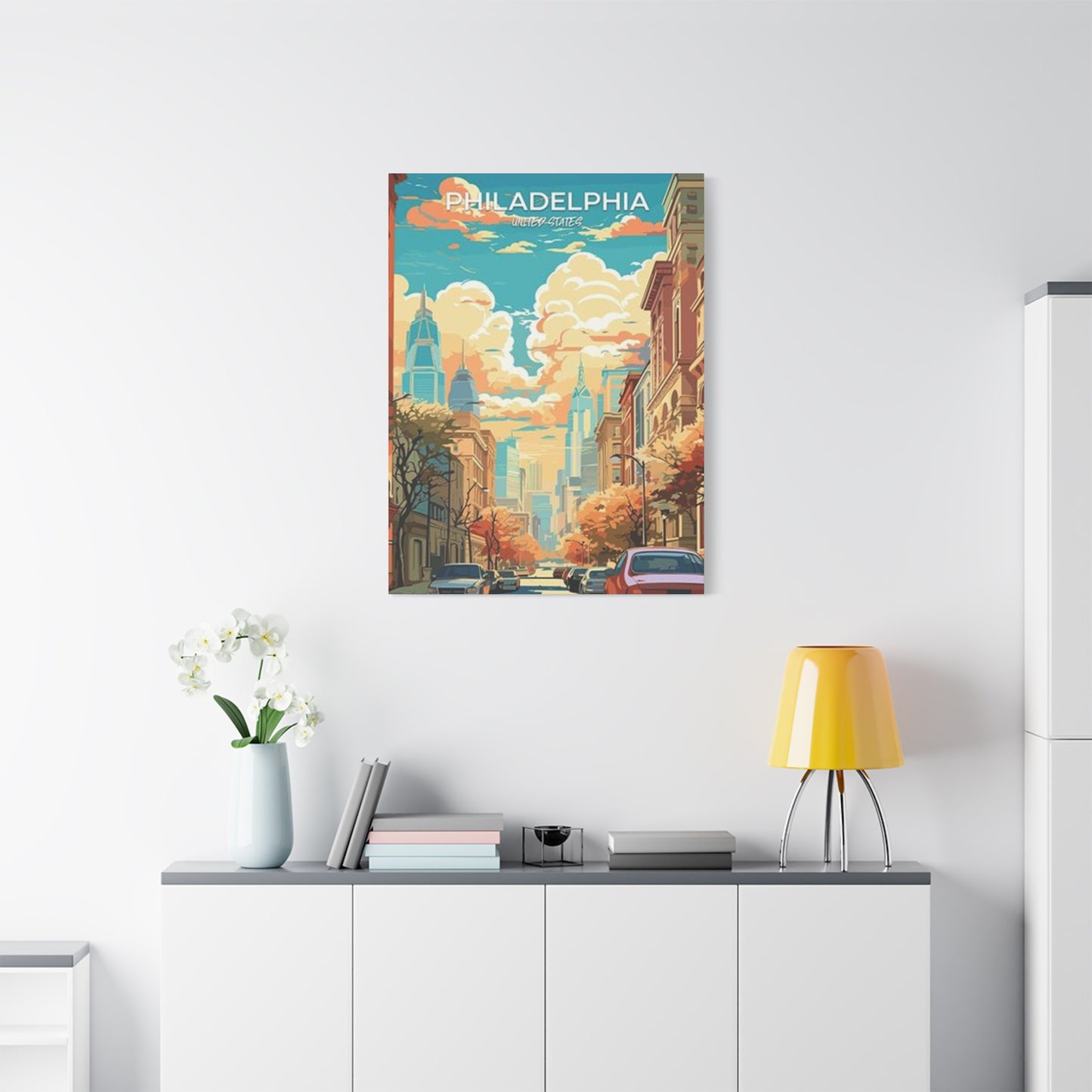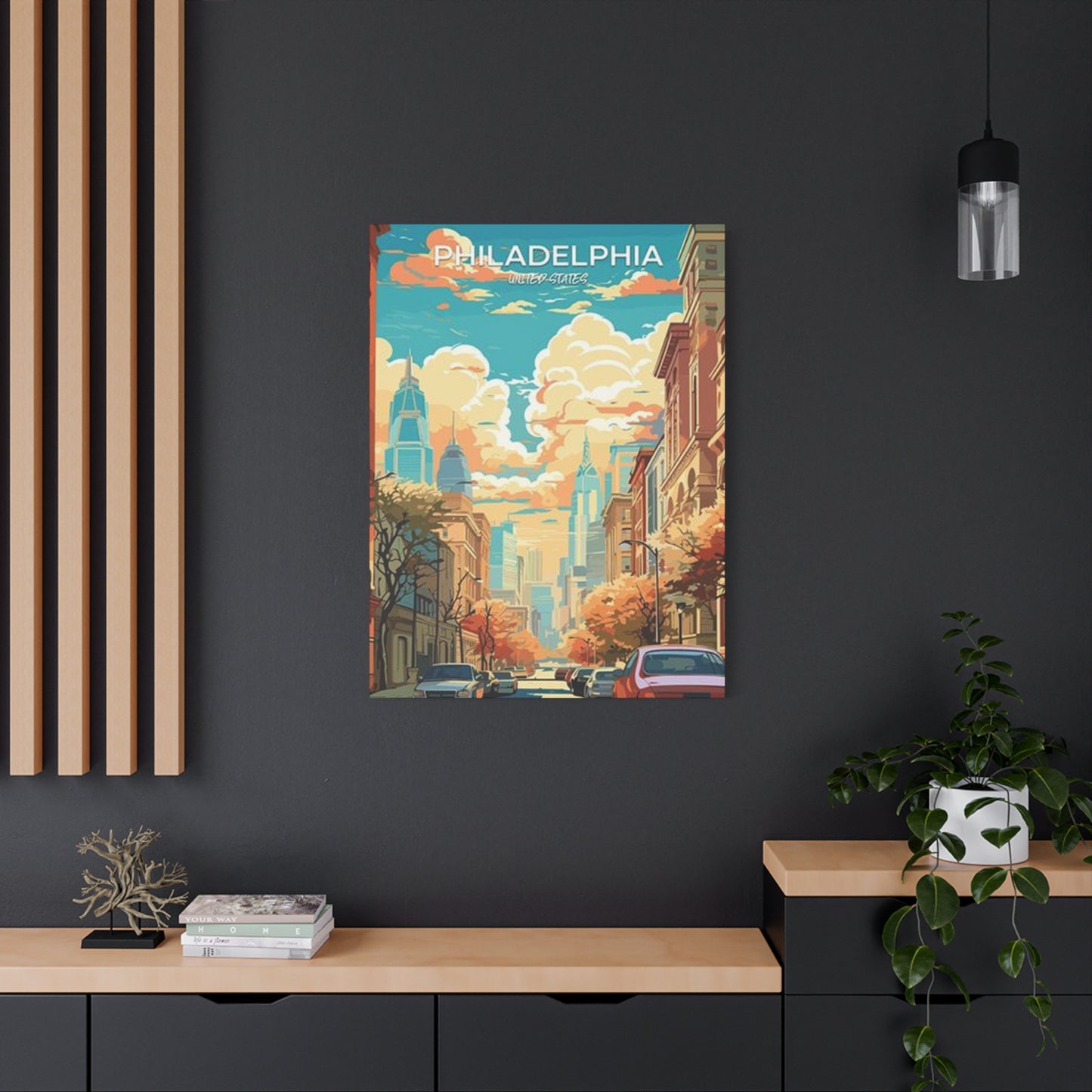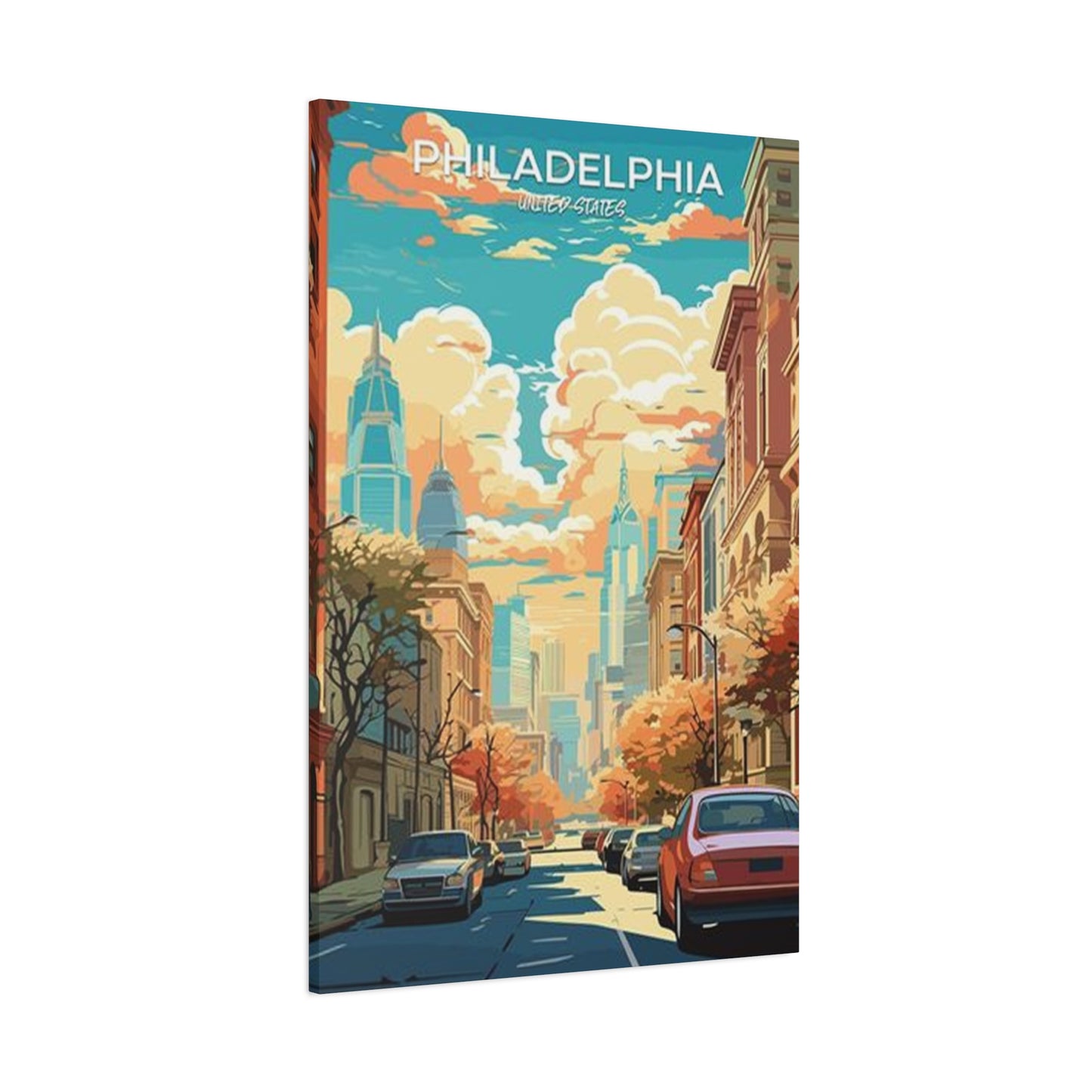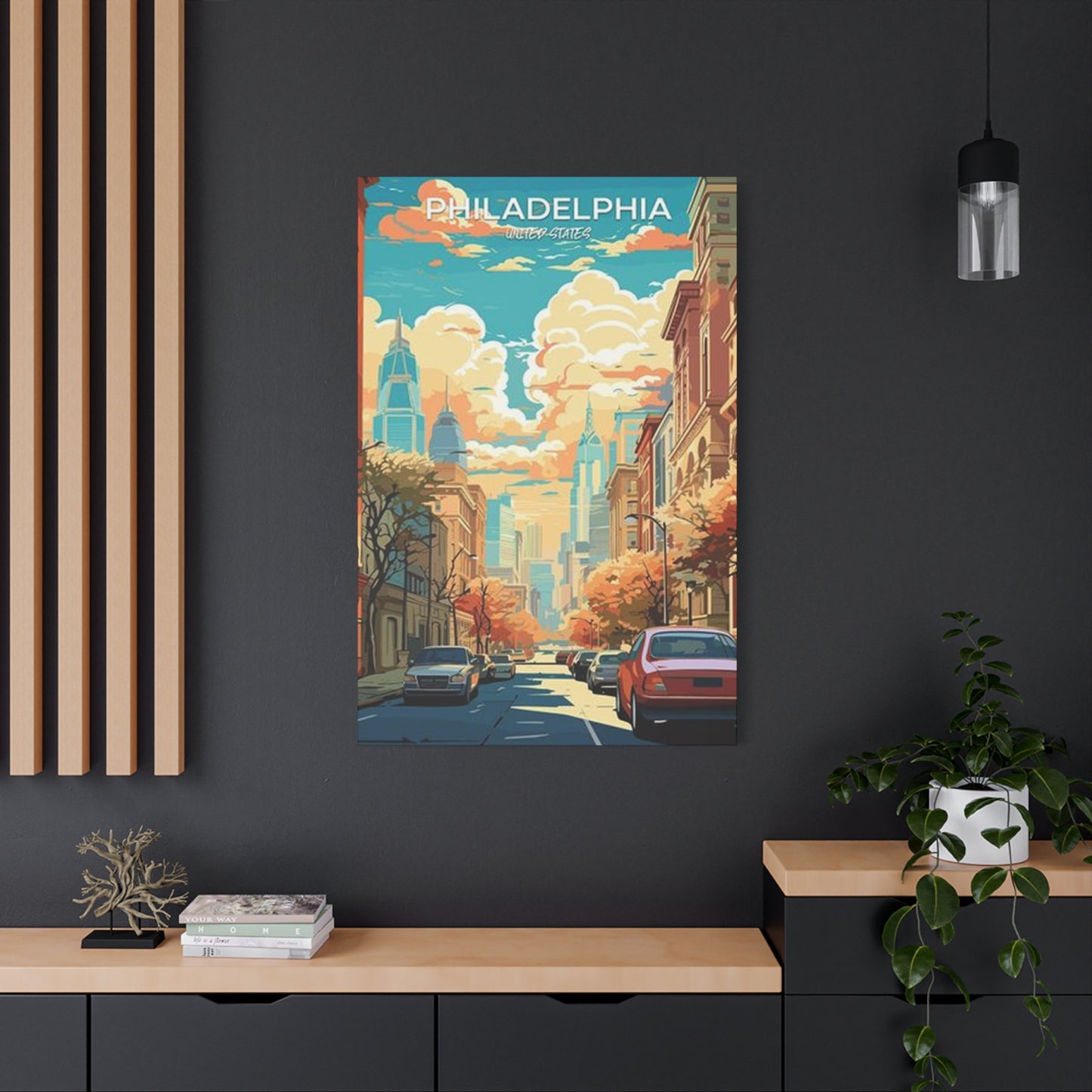Philadelphia City Streets Wall Art: A Complete Guide to Urban Décor and Artistic Expression
Philadelphia stands as one of America's most historically significant and visually captivating cities, where centuries of architectural evolution have created streetscapes that tell stories through every corner, building, and cobblestone path. The transformation of these urban landscapes into wall art and canvas prints has become increasingly popular among homeowners, office decorators, and art enthusiasts who seek to capture the essence of this remarkable city. This comprehensive guide explores every aspect of Philadelphia city streets wall art canvas prints, from their artistic merit to practical considerations for display and collection.
Understanding the Artistic Value of Philadelphia Urban Landscapes
Philadelphia's streets contain layers of visual history that make them exceptionally compelling subjects for artistic representation. When transformed into canvas prints, these streetscapes become more than mere photographs or illustrations. They represent captured moments of urban life, architectural grandeur, and cultural significance that resonate with viewers on multiple levels. The artistic value derives from several interconnected elements that work together to create visually striking compositions.
The architectural diversity found throughout Philadelphia provides artists and photographers with endless inspiration. From the colonial-era buildings of Old City to the modern skyscrapers of Center City, each neighborhood presents distinct visual characteristics. When these elements are carefully composed and printed on canvas, they create artwork that functions as both decorative pieces and conversation starters. The texture of canvas adds depth and dimension to urban photography, making flat images appear more lifelike and engaging.
Artists who specialize in Philadelphia street scenes often focus on capturing the interplay between light and shadow as it falls across historic buildings, contemporary structures, and the busy streets below. This attention to lighting conditions transforms ordinary street views into extraordinary visual experiences. The golden hour lighting during sunrise and sunset creates particularly dramatic effects when printed on high-quality canvas material. These prints often feature warm tones that add warmth and character to interior spaces.
The human element present in many Philadelphia street scenes adds another layer of artistic interest. People walking along sidewalks, crossing streets, or gathering in public spaces bring life and energy to these compositions. When scaled appropriately for canvas prints, these figures provide scale reference while also suggesting stories and narratives that viewers can interpret personally. This narrative quality makes such artwork particularly engaging for long-term display in homes and offices.
Color saturation and tonal range play crucial roles in the artistic impact of Philadelphia street art canvas prints. Some artists prefer vibrant, saturated colors that emphasize the energy and vitality of urban life, while others opt for more subdued, muted palettes that evoke nostalgia or contemplation. Black and white treatments of Philadelphia streets create timeless, classic aesthetics that complement various interior design styles. The choice of color treatment significantly influences the emotional response that artwork generates in viewers.
Exploring Philadelphia's Most Iconic Streets for Wall Art
Philadelphia contains numerous streets that have become iconic subjects for wall art due to their distinctive character, historical significance, or visual appeal. Elfreth's Alley stands as America's oldest continuously inhabited residential street, dating back to 1702. Its narrow cobblestone path flanked by colonial-era homes creates an intimate, charming scene that translates beautifully to canvas prints. The texture of aged brick, weathered shutters, and historic street lamps provides rich visual detail that rewards close examination.
Market Street, as Philadelphia's primary east-west thoroughfare, represents the city's commercial heart and architectural evolution. Canvas prints featuring this major artery often capture the dramatic contrast between historic buildings and modern structures, creating dynamic compositions that reflect Philadelphia's ongoing transformation. The wide street allows for expansive views that showcase multiple buildings simultaneously, providing comprehensive snapshots of urban development across different eras.
South Street has earned its reputation as Philadelphia's most eclectic neighborhood, where counterculture meets mainstream commerce. Wall art featuring this vibrant corridor typically emphasizes colorful storefronts, street art, and the diverse crowd that frequents this area. The visual energy present in South Street scenes makes them particularly suitable for contemporary interior spaces that embrace bold, expressive design elements. These prints often feature bright colors and dynamic compositions that draw the eye and spark curiosity.
Broad Street stretches through the city as its main north-south avenue, offering varied perspectives depending on which section is featured. The view looking south toward City Hall provides one of Philadelphia's most recognizable vistas, with the historic government building's tower dominating the skyline. Canvas prints capturing this perspective work particularly well as large-format pieces that command attention in spacious rooms. The symmetry of this view creates balanced, harmonious compositions that appeal to viewers who appreciate orderly, structured artwork.
Chestnut Street in Old City combines historical architecture with contemporary vitality, making it a favorite subject for photographers and artists. The preserved 18th and 19th-century buildings along this corridor provide textural richness and architectural detail that translate exceptionally well to canvas medium. Evening scenes along Chestnut Street, with illuminated windows and street lamps casting warm glows, create particularly atmospheric prints that add ambiance to living spaces.
Pine Street and Spruce Street in the Society Hill neighborhood showcase residential Philadelphia at its most refined. Tree-lined sidewalks, carefully maintained historic homes, and gas-style street lamps create scenes of urban elegance that appeal to viewers seeking sophisticated, understated artwork. Canvas prints of these streets work beautifully in traditional and transitional interior designs, where they complement rather than compete with existing décor elements.
Passyunk Avenue in South Philadelphia presents a completely different aesthetic, celebrating the neighborhood's Italian heritage and working-class character. The famous intersection where Passyunk meets East Passyunk Avenue offers a unique angular perspective that creates visually interesting compositions. Canvas prints featuring this area often include the neighborhood's characteristic row houses, corner stores, and community gathering spaces that reflect authentic Philadelphia neighborhood life.
Selecting the Perfect Canvas Material and Print Quality
The quality of canvas material significantly impacts the final appearance and longevity of Philadelphia street art prints. Museum-grade cotton canvas represents the premium standard for fine art reproduction, offering superior durability, color retention, and archival properties. This material type accepts ink beautifully, allowing for accurate color reproduction and fine detail preservation. Cotton canvas also maintains its structural integrity over time, resisting sagging and warping when properly stretched and mounted.
Polyester canvas blends provide more affordable alternatives while still delivering acceptable quality for most decorative applications. These synthetic materials offer increased resistance to moisture and environmental factors, making them suitable for locations where humidity or temperature fluctuations might pose challenges. The smooth surface of polyester canvas works particularly well for photographic reproductions of Philadelphia streets, where fine detail and sharp edges enhance the urban landscape's architectural elements.
Canvas weight, measured in ounces per square yard, determines the material's body and texture. Heavier canvases, typically ranging from eight to twelve ounces, provide substantial feel and professional appearance. These weights minimize transparency, preventing wall color or texture from showing through the printed image. For large-format Philadelphia street scenes, heavier canvas weights offer superior stability and reduce the risk of warping or distortion along edges.
The weave pattern of canvas material affects both the visual texture and print quality. Finely woven canvases with tight, consistent weaves provide smooth surfaces ideal for detailed photographic prints where clarity and sharpness are priorities. More textured, visible weaves create artistic effects that complement painterly or impressionistic interpretations of Philadelphia streets. The choice between these options depends on the specific image style and desired aesthetic outcome.
Giclee printing represents the gold standard for canvas reproduction, utilizing high-resolution inkjet technology with archival-quality pigment inks. This printing method achieves exceptional color accuracy, tonal range, and detail resolution. For Philadelphia street art featuring complex architectural details, subtle color gradations, or important textural elements, giclee printing ensures faithful reproduction that honors the original artwork or photograph. The archival nature of pigment inks used in giclee processes means prints maintain their visual quality for decades when properly cared for.
UV-resistant coating applications protect canvas prints from fading and deterioration caused by light exposure. Philadelphia street scenes displayed in bright rooms or near windows particularly benefit from these protective treatments. Some canvas prints receive spray coatings that provide UV protection while maintaining the canvas's natural texture, while others use liquid laminate applications that add both protection and subtle sheen. Understanding these options helps buyers select prints that will maintain their appearance throughout years of display.
Framing and Mounting Options for Urban Canvas Art
Gallery wrap stretching represents the most popular mounting method for Philadelphia street art canvas prints, where the image wraps around the edges of a wooden stretcher frame. This frameless presentation creates clean, contemporary aesthetics that allow artwork to float on walls without visual interruption. The depth of the stretcher bars, typically ranging from three-quarters of an inch to two inches, affects the piece's dimensional presence and shadow-casting qualities on the wall surface.
For gallery-wrapped canvases, the handling of image edges requires careful consideration. Image continuation, where the street scene extends around the canvas sides, creates seamless appearances when viewing from angles. Alternatively, mirror wrapping reflects the image edges onto the sides, while solid color wrapping uses neutral tones that don't compete with the main image. For detailed Philadelphia architectural scenes, image continuation often provides the most satisfactory results, maintaining visual coherence from multiple viewing perspectives.
Traditional framing with floating mounts offers more formal presentation styles that suit certain interior design contexts. In this approach, the canvas appears to float within the frame, with visible space between the artwork edge and the frame's inner border. This technique works particularly well for Philadelphia street scenes that benefit from visual containment and formal presentation. Frame selection dramatically influences the overall aesthetic, with options ranging from sleek metal profiles to ornate wooden moldings that reference traditional gallery presentations.
Shadow box framing creates dramatic dimensional effects by mounting canvas prints with substantial depth between the artwork surface and the protective glass or acrylic covering. This technique works especially well for textured or heavily embellished Philadelphia street art where physical relief adds to the artistic expression. The depth created by shadow box construction generates interesting light and shadow play that changes as viewing angles shift throughout the day.
Direct mounting to rigid substrates provides alternative presentation methods that eliminate stretcher frames entirely. Canvas prints can be adhered to materials like foam board, gatorboard, or aluminum composite panels, creating lightweight, durable display pieces. This approach particularly suits large-format Philadelphia cityscape prints where traditional framing would add substantial weight and cost. The resulting pieces hang flush against walls, creating clean, modern appearances.
Corner protectors and hanging hardware significantly impact the installation experience and long-term stability of canvas prints. Quality corner protectors prevent damage during handling and transportation, while appropriate hanging hardware ensures secure wall mounting. For substantial Philadelphia street scene prints, especially those in large formats, heavy-duty hanging systems distribute weight effectively and prevent accidents. D-rings, sawtooth hangers, and wire systems each offer advantages depending on the specific piece's size, weight, and display location.
Incorporating Philadelphia Street Art into Various Interior Design Styles
Modern minimalist interiors benefit greatly from carefully selected Philadelphia street art that emphasizes clean lines, geometric patterns, and restrained color palettes. Black and white photographs of architectural details, symmetrical street views, or abstracted urban patterns complement minimalist principles without overwhelming sparse design schemes. Large-scale single images make stronger statements than gallery walls in these contexts, serving as focal points that draw attention through simplicity rather than complexity.
Industrial design aesthetics naturally align with urban street photography and artwork. Raw materials, exposed structural elements, and utilitarian furnishings find perfect companions in Philadelphia street scenes that emphasize the city's industrial heritage, infrastructure, or working neighborhoods. Canvas prints featuring bridges, railways, factory buildings, or gritty street-level perspectives enhance industrial interiors by reinforcing their urban character and architectural honesty.
Traditional and classical interior designs accommodate Philadelphia street art when pieces emphasize historical architecture, timeless compositions, and refined presentation. Formal framing treatments, subdued color palettes, and subjects featuring landmark buildings or historic neighborhoods integrate seamlessly into traditional spaces. Canvas prints showcasing colonial architecture, elegant residential streets, or landmark institutions like City Hall work particularly well in settings with antique furniture, oriental rugs, and classical architectural details.
Contemporary eclectic interiors welcome bold, vibrant Philadelphia street art that celebrates the city's diverse character and creative energy. Mixed-media pieces, heavily saturated color treatments, and unconventional perspectives on familiar locations align with eclectic design principles. Gallery walls combining multiple Philadelphia street scenes with varying styles, sizes, and treatments create dynamic visual interest that reflects the layered, collected appearance characteristic of eclectic interiors.
Scandinavian-inspired spaces benefit from Philadelphia street art that emphasizes natural light, subtle colors, and organic urban elements. Tree-lined residential streets, parks intersecting with urban fabric, or scenes captured during golden hour with warm, soft lighting complement Scandinavian design's emphasis on nature, light, and understated beauty. Presentation in light wood frames or simple gallery wraps maintains the clean, uncluttered aesthetic central to this design philosophy.
Bohemian interiors embrace Philadelphia street art that celebrates neighborhood character, cultural diversity, and artistic expression. Colorful murals, street art, ethnic neighborhoods, and markets provide subject matter that aligns with bohemian design's celebration of creativity, travel, and cultural appreciation. Mixed presentation styles, varied frame treatments, and asymmetrical arrangements contribute to the layered, collected appearance that defines bohemian spaces.
Considerations for Maximum Visual Impact
Understanding the relationship between canvas size and viewing distance ensures optimal visual impact for Philadelphia street art. Smaller prints, typically ranging from eight by ten inches to sixteen by twenty inches, work well in intimate spaces like hallways, bathrooms, or cozy reading nooks where viewing distances remain relatively short. These sizes allow for detailed examination while fitting comfortably in constrained spaces without overwhelming their surroundings.
Medium-sized canvas prints, generally between twenty by thirty inches and thirty by forty inches, represent versatile options suitable for most living spaces. These dimensions work well above furniture pieces like sofas, beds, or console tables, where they provide substantial visual presence without dominating entire walls. Philadelphia street scenes in these sizes capture sufficient detail to reward close examination while maintaining compositional impact when viewed from across the room.
Large-format prints exceeding forty by sixty inches create dramatic focal points that command attention in spacious rooms. These substantial pieces work particularly well in great rooms, master bedrooms, or office reception areas where wall space allows for impressive scale. Philadelphia cityscape panoramas or iconic street views benefit especially from large-format treatment, where the expansive canvas allows viewers to feel immersed in the urban scene.
Vertical orientation choices emphasize height and draw the eye upward, making them particularly effective in spaces with high ceilings or narrow wall sections. Philadelphia street scenes featuring tall buildings, vertical architectural elements, or upward perspectives take advantage of vertical formats. These proportions also work well in hallways, stairwells, and beside doorways where horizontal space is limited.
Horizontal orientation selections emphasize width and create calming, stable compositions that spread across walls. Wide Philadelphia street vistas, panoramic cityscapes, or scenes emphasizing the horizontal lines of row house architecture benefit from landscape-oriented canvas prints. These proportions naturally complement furniture arrangements and architectural features like mantels, headboards, or buffets.
Square format canvases offer balanced, modern alternatives to traditional rectangular proportions. The equal dimensions create dynamic tension in compositions that might feel static in rectangular formats. Philadelphia street scenes with circular movement patterns, centered focal points, or symmetrical compositions work particularly well in square formats. These proportions also facilitate creative grouping arrangements where multiple squares combine to form larger wall installations.
Color Schemes and Their Psychological Effects in Urban Art
Monochromatic treatments of Philadelphia streets create sophisticated, timeless aesthetics that transcend temporary design trends. Black and white canvas prints emphasize form, texture, contrast, and compositional elements without the distraction of color information. These treatments often evoke nostalgia, highlight architectural details, and create cohesive visual themes when multiple pieces are displayed together. Monochromatic Philadelphia street art integrates easily into diverse interior color schemes without clashing or competing with existing palette choices.
Warm color palettes featuring reds, oranges, yellows, and warm browns create inviting, energetic atmospheres that stimulate conversation and activity. Philadelphia street scenes emphasizing brick architecture, sunset lighting, autumn foliage, or warm artificial lighting benefit from warm color treatments. These palettes psychologically promote feelings of comfort, enthusiasm, and social engagement, making them particularly suitable for living rooms, dining areas, and social spaces.
Cool color schemes incorporating blues, greens, and purples generate calming, contemplative moods that promote relaxation and focus. Philadelphia street art emphasizing shadows, evening blue hours, water features, or park elements naturally supports cool palette treatments. These color choices work particularly well in bedrooms, home offices, and meditation spaces where peaceful, focused atmospheres enhance the space's function.
Complementary color relationships, utilizing opposite hues on the color wheel, create vibrant, dynamic visual experiences that energize spaces. Philadelphia street scenes featuring blue skies against orange brick buildings, or green parks beside red-toned structures, exemplify complementary color harmony. These high-contrast relationships generate visual excitement and draw attention, making them effective choices for spaces where artwork should serve as a bold statement.
Analogous color schemes using adjacent colors on the color wheel produce harmonious, cohesive effects that create unity and flow. Philadelphia street art might employ various blue shades, or progress through yellows, oranges, and reds, maintaining color family relationships throughout the composition. These subtle color progressions create sophisticated visual interest without the jarring contrast of complementary schemes, working well in spaces prioritizing calm elegance over dramatic impact.
Muted, desaturated color treatments create sophisticated, understated aesthetics that whisper rather than shout. Philadelphia street scenes processed with reduced color saturation evoke vintage photography, faded memories, or artistic restraint. These subtle palettes work beautifully in refined interiors where artwork should enhance rather than dominate, and where visual harmony across all design elements is prioritized.
Philadelphia Architecture as Canvas Art Subjects
Colonial-era structures scattered throughout Philadelphia provide rich subject matter for canvas prints that celebrate America's founding period. Buildings dating from the 17th and 18th centuries feature distinctive architectural elements including brick construction, shuttered windows, dormer roofs, and chimneys that create visually interesting compositions. These historic structures, when captured in appropriate lighting and context, create artwork that functions as both aesthetic pieces and historical documentation.
Federal and Georgian architectural styles prominent in Philadelphia's older neighborhoods showcase symmetry, proportion, and classical details that translate beautifully to canvas prints. Fanlight windows, columned porticos, decorative cornices, and balanced facades create orderly compositions that appeal to viewers who appreciate structured, harmonious design. These architectural styles represent important periods in American development, adding layers of meaning and significance to decorative artwork.
Victorian-era buildings throughout Philadelphia present ornate details, varied textures, and romantic proportions that create visually rich canvas subjects. Bay windows, elaborate ironwork, decorative brickwork, and asymmetrical arrangements generate complex compositions that reward extended viewing. Canvas prints featuring Victorian architecture work particularly well in spaces that embrace ornamentation, layered decoration, and collected aesthetics.
Art Deco and early modernist structures from Philadelphia's 20th-century building boom offer streamlined forms, geometric patterns, and bold vertical emphasis that create dramatic canvas prints. These architectural styles represent important transitions in design philosophy, showcasing how form and function merged in urban development. Canvas prints emphasizing these structures appeal to viewers who appreciate mid-century aesthetics and the optimistic, progressive spirit these buildings represent.
Industrial architecture including factories, warehouses, and infrastructure elements provides gritty, authentic Philadelphia subjects that celebrate the city's working-class heritage. Brick factory buildings, loading docks, railway structures, and utility installations create compositions emphasizing texture, repetition, and utilitarian beauty. These subjects work particularly well for canvas prints intended for industrial or masculine design schemes where raw authenticity is valued.
Contemporary architectural additions to Philadelphia's streetscape showcase current design trends and the city's ongoing evolution. Glass towers, innovative residential developments, and modern institutional buildings provide sleek, forward-looking subjects that contrast with or complement historic structures. Canvas prints featuring contemporary architecture appeal to viewers who appreciate cutting-edge design and want artwork that reflects Philadelphia's current identity rather than only its past.
Seasonal Variations in Philadelphia Street Photography
Spring transformations along Philadelphia streets provide fresh, optimistic subject matter for canvas prints. Blooming trees lining residential streets, spring flowers in planters and gardens, and the renewed energy of pedestrians after winter create compositions celebrating rebirth and growth. The soft greens and pastel colors typical of spring create gentle, welcoming palettes that work well in spaces seeking to introduce natural, organic color schemes.
Summer vibrancy in Philadelphia generates bold, saturated colors and strong lighting conditions that create dramatic canvas prints. Full tree canopies creating dappled shade patterns, outdoor dining scenes, crowded sidewalks, and intense blue skies contribute to compositions celebrating urban vitality and warm-weather activity. The longer daylight hours of summer provide extended golden hour periods ideal for capturing warm, glowing street scenes that add warmth to interior spaces.
Autumn splendor transforms Philadelphia streets with spectacular foliage colors that create some of the most visually striking canvas print subjects. Tree-lined streets ablaze with reds, oranges, and yellows against classic architecture produce naturally beautiful compositions requiring minimal enhancement. The comfortable temperatures and clear skies typical of Philadelphia autumns create ideal photography conditions, resulting in crisp, detailed images that reproduce beautifully on canvas.
Winter atmospheres along Philadelphia streets offer unique aesthetic opportunities emphasizing stark beauty, architectural bones, and seasonal charm. Snow-covered streets, holiday decorations, bare tree branches creating delicate patterns against buildings, and the warm glow of interior lights against cold exterior conditions create atmospheric scenes. Canvas prints capturing winter Philadelphia work particularly well in spaces where seasonal rotation of artwork maintains fresh visual interest throughout the year.
Weather-specific conditions including rain-slicked streets, foggy mornings, or dramatic storm clouds create moody, atmospheric Philadelphia street scenes that emphasize emotional resonance over documentary accuracy. These conditions transform familiar locations into mysterious, romantic, or dramatic settings that engage viewers on deeper psychological levels. Canvas prints featuring weather-specific Philadelphia scenes work particularly well in spaces where contemplative or sophisticated atmospheres are desired.
Time-of-day variations significantly impact the character of Philadelphia street photography. Golden hour lighting during early morning or late afternoon creates warm, glowing conditions that add beauty to any scene. Blue hour photography captured during twilight generates cool, sophisticated atmospheres with interesting artificial lighting contrasts. Midday photography emphasizes architectural details and creates high-contrast scenes, while nighttime photography showcases Philadelphia's illuminated character and creates dramatic, vibrant canvas subjects.
Creating Gallery Walls with Multiple Philadelphia Street Prints
Symmetrical gallery wall arrangements create orderly, balanced presentations that work well in formal spaces or traditional interiors. Philadelphia street prints arranged in grid patterns with consistent spacing and frame treatments generate unified appearances that read as single compositional elements rather than collections of individual pieces. These arrangements work particularly well when all prints share common characteristics such as color treatment, subject matter focus, or photographic style.
Asymmetrical gallery walls offer dynamic, modern alternatives that create visual interest through varied arrangement patterns. Mixing different sizes of Philadelphia street prints in organic groupings that balance visual weight without matching precise alignments generates contemporary, collected aesthetics. These arrangements work well in eclectic or modern interiors where formal symmetry might feel too rigid or traditional.
Linear arrangements along horizontal or vertical axes create clean, streamlined gallery presentations that work well in hallways, above long furniture pieces, or in spaces with architectural features that suggest directional emphasis. Philadelphia street prints arranged in single rows with consistent spacing and alignment create unified visual flows that guide the eye along the arrangement's path.
Salon-style walls featuring densely packed arrangements of various sizes and shapes create maximalist presentations that celebrate abundance and visual richness. Philadelphia street prints in salon arrangements might include different neighborhoods, architectural styles, seasonal variations, and presentation treatments, unified through consistent framing or color relationships. These arrangements work particularly well in spaces embracing bold, confident design approaches.
Thematic groupings organize multiple Philadelphia street prints around unifying concepts, subjects, or characteristics. A gallery wall might feature all images from a single neighborhood, all architectural styles from a particular era, all seasonal variations of the same location, or all abstract interpretations of urban elements. These thematic approaches create cohesive narratives that invite viewers to explore relationships between individual pieces.
Color coordination strategies unify diverse Philadelphia street prints through shared color characteristics. Gallery walls might feature all monochromatic images, all warm-toned scenes, or pieces sharing a specific accent color that appears in each composition. This approach allows for subject matter variety while maintaining visual coherence through color relationships.
Value and Collecting Philadelphia Urban Art
Limited edition canvas prints offer collectors opportunities to acquire Philadelphia street art with inherent scarcity value. When artists or publishers limit production runs to specific quantities and provide certificates of authenticity, individual prints gain collectible status beyond their decorative function. Numbered editions from established Philadelphia photographers or artists may appreciate in value over time as the artist's reputation grows or as the limited availability increases demand.
Artist signatures and authenticity documentation significantly impact the investment potential of Philadelphia street art canvas prints. Hand-signed pieces by recognized photographers or artists carry greater value than unsigned reproductions, even when the image quality is identical. Certificates of authenticity that document the artwork's provenance, edition information, and production details provide important verification that supports future resale value.
Emerging Philadelphia artists offer collecting opportunities at accessible price points while potentially providing substantial value appreciation. Identifying talented local photographers and artists early in their careers allows collectors to acquire quality work affordably while supporting developing artistic voices. As these artists gain recognition and establish reputations, early acquisitions may significantly appreciate, rewarding collectors who recognized talent before broader market acknowledgment.
Historical Philadelphia photography reproduced as contemporary canvas prints provides both aesthetic appeal and historical documentation value. Vintage photographs from Philadelphia's past, when properly licensed and professionally reproduced on quality canvas, create artwork that captures the city's evolution while functioning as historical records. These pieces appeal to history enthusiasts, Philadelphia natives, and collectors interested in urban development documentation.
Condition preservation directly impacts the long-term value of Philadelphia street art canvas prints. Proper framing with UV protection, controlled environmental conditions avoiding extreme temperature or humidity, and careful handling during cleaning or relocation maintain artwork in optimal condition. Well-preserved pieces retain their visual quality and market value significantly better than neglected works showing fading, staining, or physical damage.
Market research helps collectors make informed decisions about Philadelphia street art acquisitions. Understanding current market values for specific artists, subjects, or styles prevents overpaying while also identifying undervalued opportunities. Following gallery exhibitions, auction results, online marketplace transactions, and critical reception of Philadelphia-themed art provides valuable context for collection development decisions.
Customization Options for Personal Connection
Custom canvas prints from personal photographs allow individuals to display their own Philadelphia street photography as professional-quality wall art. Services that transform digital images into canvas prints make personal urban photography accessible for home and office display. This approach creates deeply personal connections to displayed artwork, as each piece represents not only Philadelphia locations but also individual experiences, perspectives, and memories.
Color adjustment and enhancement services optimize personal Philadelphia photography for canvas reproduction. Professional editing addresses common issues including exposure problems, color casts, and composition weaknesses that might diminish canvas print quality. These services balance enhancement with authenticity, improving technical quality while maintaining the original photograph's character and intent.
Size scaling and cropping options allow personal Philadelphia street photography to fit specific display locations and design requirements. Professional printing services can adapt images to required dimensions while maintaining optimal resolution and composition balance. Cropping can emphasize specific elements, eliminate distracting periphery details, or adjust aspect ratios to match available wall space.
Text overlay additions personalize Philadelphia street art with meaningful dates, quotes, coordinates, or other textual elements. Commemorating specific visits, celebrating moves to Philadelphia, marking significant life events associated with particular locations, or simply identifying featured streets adds personalization that transforms generic urban art into meaningful personal statements. Thoughtful typography selection ensures text additions enhance rather than detract from the underlying imagery.
Mixed media treatments combine Philadelphia street photography with artistic techniques including painting, illustration, or digital manipulation. These approaches transform straightforward documentation into unique artistic expressions that bridge photography and fine art. Mixed media treatments create one-of-a-kind pieces that reflect individual aesthetic preferences while maintaining connections to recognizable Philadelphia locations.
Multiple panel presentations divide single Philadelphia street scenes across several canvas panels, creating dynamic installations with dimensional depth. Diptychs, triptychs, and larger multi-panel arrangements add visual interest through separation and sequencing while allowing for impressive scale. These presentations work particularly well with panoramic Philadelphia street views that benefit from horizontal expansion across wall space.
Lighting Techniques for Displaying Urban Canvas Art
Natural lighting considerations significantly impact how Philadelphia street art canvas prints appear in displayed spaces. North-facing windows provide consistent, indirect illumination that minimizes color distortion and reduces fading risks. South-facing locations receive more intense, warmer light that can enhance certain color palettes while potentially accelerating fading without proper UV protection. Understanding how natural light in specific locations affects artwork appearance helps in both piece selection and placement decisions.
Accent lighting using picture lights, track lighting, or recessed fixtures draws attention to Philadelphia street art while controlling how the artwork appears. Dedicated artwork lighting allows for consistent illumination regardless of ambient light conditions, ensuring canvas prints appear as intended throughout different times of day. Adjustable fixtures permit fine-tuning of light direction and intensity to minimize glare while maximizing visual impact.
LED lighting technology offers energy-efficient, heat-reducing alternatives to traditional artwork illumination. The cool operation of LED fixtures eliminates the canvas damage risks associated with heat-producing incandescent or halogen lights. Color-accurate LED options with high Color Rendering Index ratings ensure Philadelphia street art appears with true, natural colors rather than the distorted hues that some lighting produces.
Ambient room lighting affects how Philadelphia street art integrates within overall interior design schemes. Warmer ambient lighting emphasizes warm tones in artwork while muting cool colors, while cooler ambient lighting produces opposite effects. Considering the dominant lighting character in display spaces during selection ensures canvas prints harmonize with typical viewing conditions rather than appearing disconnected from their environments.
Glare management requires attention to canvas print placement relative to light sources. Direct light reflecting off canvas surfaces creates hotspots that obscure image details and reduce viewing comfort. Positioning artwork to avoid direct reflections from windows or light fixtures, or using adjustable lighting that can be directed to minimize glare, ensures Philadelphia street scenes remain clearly visible and visually accessible.
Layered lighting approaches combine multiple light sources at different intensities to create depth and dimension in rooms while properly illuminating artwork. General ambient lighting provides overall visibility, task lighting supports specific activities, and accent lighting highlights Philadelphia street art and other decorative elements. This layered approach creates sophisticated, flexible environments where artwork receives appropriate attention without overwhelming dominating spaces.
Maintaining Canvas Print Quality
Regular dusting prevents particle accumulation that can dull Philadelphia street art canvas prints over time. Soft, dry microfiber cloths or soft-bristle brushes gently remove surface dust without scratching or abrading canvas texture. Dusting should proceed gently in one direction rather than circular motions, and should avoid applying pressure that might stretch or distort canvas material. Regular maintenance at intervals appropriate to household dust levels keeps artwork appearing fresh and vibrant.
Humidity control protects canvas prints from moisture-related damage including mold, mildew, and structural warping. Maintaining relative humidity between thirty and fifty percent prevents both excessive dryness that can make canvas brittle and excessive moisture that promotes biological growth. Dehumidifiers in humid climates and humidifiers in arid conditions help maintain optimal environmental stability for Philadelphia street art preservation.
Temperature stability prevents canvas expansion and contraction that can lead to cracking, warping, or separation from stretcher frames. Avoiding artwork placement near heat sources like radiators, fireplaces, or heating vents protects canvas integrity. Similarly, avoiding exterior walls in climates with extreme temperature swings minimizes thermal cycling that stresses canvas material and mounting systems.
Direct sunlight avoidance represents one of the most important preservation measures for Philadelphia street art canvas prints. Ultraviolet radiation causes irreversible fading, color shifting, and material degradation even in prints with UV-protective coatings. Positioning artwork away from windows, using window treatments to filter sunlight, or displaying prints in interior walls eliminates the primary environmental threat to long-term canvas print preservation.
Professional cleaning services address issues beyond routine maintenance capabilities. When canvas prints develop stains, discoloration, or other problems requiring intervention beyond simple dusting, professional art conservators possess specialized knowledge and materials for safe cleaning. Attempting aggressive cleaning without professional expertise risks permanent damage, making conservative maintenance approaches combined with occasional professional assessment the wisest preservation strategy.
Periodic inspection identifies developing problems before they become serious threats to Philadelphia street art canvas prints. Checking for loose stretcher corners, sagging canvas, fading colors, or developing stains at regular intervals allows for timely intervention. Catching problems early often permits simple corrections that prevent progression to conditions requiring expensive professional restoration.
Transportation and Storage Best Practices
Protective wrapping prevents physical damage during Philadelphia street art canvas print transportation or storage. Acid-free glassine paper placed directly against print surfaces protects from scratches and abrasion, while bubble wrap adds cushioning for additional impact protection. Avoiding direct plastic contact with printed surfaces prevents condensation trapping and potential image transfer issues. Secure wrapping maintains protection while allowing for safe handling and movement.
Rigid backing boards provide structural support during transportation, preventing bending or warping of canvas prints. Corrugated cardboard, foam board, or custom wooden crates sized to match artwork dimensions distribute forces during handling and protect against impacts. For valuable or large Philadelphia street art pieces, custom wooden crates offer maximum protection during shipping or long-distance transportation.
Vertical orientation during storage prevents pressure accumulation that can damage canvas prints stored horizontally. When multiple pieces must be stored together, maintaining vertical positioning with adequate spacing between works prevents contact that might cause scratching or image transfer. Storage racks designed for artwork provide proper support while maximizing space efficiency.
Climate-controlled storage environments protect Philadelphia street art canvas prints during extended storage periods. Maintaining consistent temperature and humidity levels prevents the damaging effects of environmental fluctuations. Storage units with climate control capabilities provide this protection, though costs typically exceed standard storage options. For valuable collections or long-term storage needs, climate control represents worthwhile investment for preservation.
Documentation before storage including photographs and condition notes provides important references for insurance purposes and condition monitoring. Recording any existing damage, noting specific features or details, and creating visual records establishes baselines for assessing any changes occurring during storage. This documentation proves valuable for insurance claims if damage occurs and helps identify gradual deterioration requiring attention.
Insurance coverage for valuable Philadelphia street art during transportation or storage provides financial protection against loss, damage, or theft. Standard homeowner policies may provide limited coverage, while specialized art insurance offers comprehensive protection specifically designed for valuable collections. Understanding coverage limits, exclusions, and claim procedures before incidents occur ensures appropriate protection for significant investments in Philadelphia urban art.
Digital Art Versus Traditional Photography in Urban Prints
Digital illustration techniques create stylized interpretations of Philadelphia streets that differ dramatically from photographic representations. Artists using digital tools can emphasize, minimize, or eliminate elements as desired, creating compositions impossible through traditional photography. These approaches produce artwork ranging from subtle enhancements to dramatic transformations, offering collectors alternatives to straight photography's documentary approach. Digital illustration allows for creative expression that transforms familiar Philadelphia locations into imaginative, personalized visions.
Photo manipulation and compositing combine multiple images or add elements not present in original captures, creating enhanced or fantastical versions of Philadelphia streets. These techniques might involve sky replacements for more dramatic skies, removing unwanted elements like utility wires or signage, or combining elements from multiple photographs into single compositions. The results offer polished, idealized versions of Philadelphia locations that emphasize beauty while maintaining recognizable connection to real places.
Watercolor and painting effects applied to Philadelphia street photography bridge photographic realism and artistic interpretation. Digital filters simulating traditional art media create results resembling hand-painted artwork while retaining photographic foundations. These treatments appeal to collectors who appreciate both the accuracy of photography and the aesthetic softness of traditional art forms, offering hybrid approaches that combine strengths of both mediums.
Vector art representations of Philadelphia streets create graphic, simplified interpretations emphasizing shapes, colors, and patterns over photographic detail. These stylized approaches reduce scenes to essential elements, creating bold, contemporary artwork that functions more as graphic design than documentary photography. Vector-based Philadelphia street art works particularly well in modern interiors and commercial spaces where bold graphics complement design aesthetics.
Abstract transformations of Philadelphia street photography emphasize color, texture, pattern, or emotion over recognizable representation. Heavy manipulation produces results that may only suggest urban origins rather than depicting specific locations. These approaches create artwork that functions primarily as aesthetic objects rather than place-specific representations, appealing to collectors who value emotional resonance and visual interest over literal depictions.
Traditional film photography of Philadelphia streets offers unique aesthetic qualities including grain structure, color characteristics, and tonal ranges different from digital capture. Some photographers continue using film specifically for these distinctive qualities, which create nostalgic or classic aesthetics when reproduced as canvas prints. The analog process imposes constraints that many artists find creatively stimulating, producing results reflecting thoughtful composition and technique rather than post-capture manipulation possibilities.
Philadelphia Neighborhoods as Distinct Art Themes
Old City, Philadelphia’s historic heart, offers a rich and layered artistic theme grounded in its colonial heritage and vibrant cultural tapestry. As the birthplace of American independence, Old City’s art themes often blend history, patriotism, and urban revival—making it a dynamic canvas for creative expression.
Visual art inspired by Old City frequently draws on iconic landmarks such as Independence Hall, the Liberty Bell, and cobblestone streets lined with colonial-era architecture. These elements evoke a sense of timelessness and reverence for the past, often depicted through classic, detailed realism or stylized historical motifs. Artists may incorporate sepia tones, weathered textures, and vintage typography reminiscent of 18th-century documents, newspapers, or maps to reinforce the neighborhood’s historic aura.
Simultaneously, Old City embraces contemporary art, with galleries and street murals celebrating Philadelphia’s thriving modern art scene. This blend of old and new creates a compelling contrast—murals might feature bold colors and abstract forms juxtaposed against historic facades, symbolizing the neighborhood’s evolution and creative renaissance.
Themes of freedom, revolution, and civic pride often permeate artworks inspired by Old City. Symbolism such as eagles, stars, and liberty caps can be subtle or overt, honoring the neighborhood’s role in shaping American identity. Meanwhile, vibrant street art and public installations reflect the energy and diversity of its current residents, merging heritage with innovation.
In interior design or home decor inspired by Old City, one might see a mix of vintage maps, framed prints of historic sites, and modern abstract pieces that capture the neighborhood’s duality. Materials like aged wood, wrought iron, and exposed brick echo the area’s architecture, grounding the artistic theme in tangible textures.
Conclusion
Philadelphia city streets wall art is more than just a decorative choice—it is a vibrant celebration of urban life, history, and culture that transforms any space into a dynamic expression of the city’s unique identity. Through the artistic lens, Philadelphia’s streets come alive with stories of resilience, diversity, and creativity, making wall art an essential medium for capturing the pulse of this historic metropolis.
One of the most compelling aspects of Philadelphia city streets wall art is its ability to encapsulate the city’s rich tapestry of neighborhoods, architecture, and street culture. Whether it’s the iconic landmarks like the Liberty Bell and Independence Hall, the colorful murals of South Philadelphia, or the bustling energy of Market Street, each piece offers a window into the everyday vibrancy of urban life. These artworks serve as both homage and narrative, inviting viewers to experience the city’s spirit through bold colors, intricate details, and compelling compositions.
Incorporating Philadelphia street art into your home or office allows you to connect with the city’s cultural heartbeat, no matter where you are. The art reflects the diversity of its inhabitants, showcasing influences from various communities that have shaped Philadelphia over the decades. This celebration of multiculturalism enriches your décor, fostering a sense of inclusion and appreciation for the city’s evolving identity. Moreover, street art often carries social and political messages, making it a powerful form of artistic expression that sparks dialogue and awareness.
The versatility of Philadelphia city streets wall art also makes it an excellent choice for a wide range of interior styles. From modern lofts and industrial spaces to cozy apartments and traditional homes, urban art can be adapted to fit diverse aesthetic preferences. Large-scale prints can create dramatic focal points, while smaller pieces or framed collections add subtle yet impactful accents. By layering different styles—from graffiti-inspired works to realistic cityscapes—you can craft a personalized urban gallery that resonates with your connection to Philadelphia.
In terms of decoration strategies, thoughtful placement and complementary décor can enhance the impact of your Philadelphia street art. Positioning artwork in high-traffic areas such as entryways, living rooms, or workspaces invites engagement and conversation. Pairing art with industrial elements like exposed brick, metal fixtures, or reclaimed wood amplifies the urban vibe, creating a cohesive and immersive environment. Additionally, incorporating local memorabilia or photography alongside the art deepens the narrative, allowing your space to tell a richer story.
Beyond aesthetic appeal, Philadelphia city streets wall art contributes to a sense of community and pride. It celebrates not only the physical landscape but also the people who give the city its character and soul. Displaying such art is a way of honoring the collective experiences, struggles, and triumphs that define Philadelphia. For residents and admirers alike, this connection fosters a sense of belonging and shared identity that transcends geographical boundaries.
Finally, engaging with Philadelphia street art supports local artists and the creative economy. Many urban artists infuse their work with personal histories and social commentary, offering authentic voices that enrich the city’s cultural fabric. By choosing to incorporate their art into your décor, you participate in sustaining and promoting Philadelphia’s vibrant artistic community. This support helps preserve the city’s legacy of creativity and innovation for future generations.
In conclusion, Philadelphia city streets wall art is a compelling and multifaceted form of urban décor that goes beyond mere aesthetics. It embodies the spirit, history, and diversity of one of America’s most storied cities, offering a visual narrative that transforms any space into a living tribute to Philadelphia’s dynamic urban culture. Whether through bold murals, detailed cityscapes, or abstract interpretations, this art invites us to explore, reflect, and celebrate the essence of the city and its people. By thoughtfully integrating Philadelphia street art into your environment, you create not only a beautiful space but also a meaningful connection to the vibrant soul of Philadelphia.

















